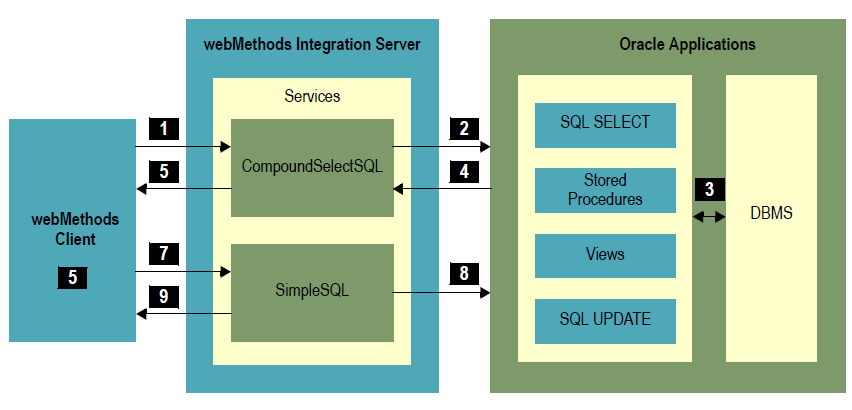
Step | Description |
1. | The webMethods client invokes a service to update the Oracle DBMS. You created this service from a transaction definition that is based on a set of specific open interface tables. The service receives the information required by the open interface table via the service specification. |
2. | The service executes. It connects to the Oracle Applications Instance via JDBC and inserts data into the open interface tables that are associated with the service. |
3. | The service receives output to indicate that the table insert is complete. |
4. | Output is returned to the client. |
5. | An Oracle Applications import process runs in the Oracle concurrent manager. The import process moves the data from the open interface tables to the live Oracle DBMS. If errors occur in the import process, Oracle records them in the appropriate open interface table. |
6. | The webMethods client invokes a service to query Oracle Applications for errors that might have occurred during the import process. You created this service from a transaction definition that is based on a stored procedure, view, or SQL SELECT statement. The service receives the query parameters for the SQL statement via the service specification. The service can also be invoked by the webMethods scheduler to periodically pull out transactions for a trading partner. |
7. | The service executes. It connects to the Oracle Applications Instance via JDBC. Based on the transaction definition used to create the service, the service does one of the following: |
8. | The stored procedure or SQL SELECT statement retrieves information from the DBMS. |
9. | The retrieved information is returned to the service. |
10. | The service returns output back to the webMethods client. |

Step | Description |
1. | The webMethods client invokes a service that you created from a transaction definition that is based on a stored procedure, view, or SQL SELECT statement. The service passes query parameters to the stored procedure, view, or SQL SELECT statement. |
2. | The service executes. It connects to the Oracle Applications Instance via JDBC. Based on the transaction definition used to create the service, the service does one of the following: |
3. | The stored procedure or SQL SELECT statement retrieves information from the DBMS. |
4. | The retrieved information is returned to the adapter service. |
5. | The service returns the output to the webMethods client. |
6. | The webMethods client optionally performs internal processing or invokes services. For example, you might choose to update your SAP system at this stage. |
7. | If there is an acknowledgment service defined for the transaction, the flow needs to execute it. The acknowledgment service connects to the Oracle Applications instance via JDBC. Based on the transaction definition used to create it, the service does one of the following: Note: The acknowledgment service is necessary for Oracle Applications to maintain the accurate status of transactions. For example, suppose that a purchase order has state of “approved” in the DBMS. It remains “approved” until an acknowledgment from the client is received, which changes the state to “approved, printed.” This ensures that the purchase order, which has already been received by the client, will not be included in the next data retrieval transaction. |
8. | The adapter service tells the Oracle Applications instance that the transaction has been processed. |
9. | The service returns output back to the webMethods client. |